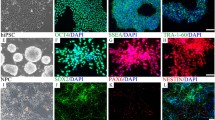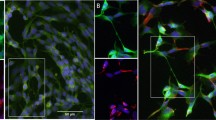Abstract
Induced pluripotent stem cell (iPSC)-derived neurons permit the study of neurogenesis and neurological disease in a human setting. However, the electrophysiological properties of iPSC-derived neurons are consistent with those observed in immature cortical neurons, including a high membrane resistance depolarized resting membrane potential and immature firing properties, limiting their use in modeling neuronal activity in adult cells. Based on the proven association between inhibiting rho kinase (ROCK) and increased neurite complexity, we seek to determine if short-term ROCK inhibition during the first 1–2 weeks of differentiation would increase morphological complexity and electrophysiological maturity after several weeks of differentiation. While inhibiting ROCK resulted in increased neurite formation after 24 h, this effect did not persist at 3 and 6 weeks of age. Additionally, there was no effect of ROCK inhibition on electrophysiological properties at 2–3, 6, or 12 weeks of age, despite an increase in evoked and spontaneous firing and a more hyperpolarized resting membrane potential over time. These results indicate that while there is a clear effect of time on electrophysiological maturity, ROCK inhibition did not accelerate maturity.



Similar content being viewed by others
References
Amano M, Fukata Y, Kaibuchi K (2000) Regulation and functions of Rho-associated kinase. Exp Cell Res 261:44–51. https://doi.org/10.1006/excr.2000.5046
Bardy C et al (2015) Neuronal medium that supports basic synaptic functions and activity of human neurons in vitro. Proc Natl Acad Sci U S A 112:E2725–E2734. https://doi.org/10.1073/pnas.1504393112
Bardy C et al (2016) Predicting the functional states of human iPSC-derived neurons with single-cell RNA-seq and electrophysiology. Mol Psychiatry 21:1573–1588. https://doi.org/10.1038/mp.2016.158
Bean BP (2007) The action potential in mammalian central neurons. Nat Rev Neurosci 8:451–465. https://doi.org/10.1038/nrn2148
Belinsky GS, Rich MT, Sirois CL, Short SM, Pedrosa E, Lachman HM, Antic SD (2014) Patch-clamp recordings and calcium imaging followed by single-cell PCR reveal the developmental profile of 13 genes in iPSC-derived human neurons. Stem Cell Res 12:101–118. https://doi.org/10.1016/j.scr.2013.09.014
Bellin M, Marchetto MC, Gage FH, Mummery CL (2012) Induced pluripotent stem cells: the new patient? Nat Rev Mol Cell Biol 13:713–726. https://doi.org/10.1038/nrm3448
Bilican B et al (2014) Physiological normoxia and absence of EGF is required for the long-term propagation of anterior neural precursors from human pluripotent cells. PLoS One 9:e85932. https://doi.org/10.1371/journal.pone.0085932
Bradford AB, McNutt PM (2015) Importance of being Nernst: synaptic activity and functional relevance in stem cell-derived neurons. World J Stem Cells 7:899–921. https://doi.org/10.4252/wjsc.v7.i6.899
Brennand KJ et al (2015) Creating patient-specific neural cells for the in vitro study of brain disorders. Stem Cell Reports 5:933–945. https://doi.org/10.1016/j.stemcr.2015.10.011
Brennand KJ, Simone A, Jou J, Gelboin-Burkhart C, Tran N, Sangar S, Li Y, Mu Y, Chen G, Yu D, McCarthy S, Sebat J, Gage FH (2011) Modelling schizophrenia using human induced pluripotent stem cells. Nature 473(7346):221–225
Chan CC, Khodarahmi K, Liu J, Sutherland D, Oschipok LW, Steeves JD, Tetzlaff W (2005) Dose-dependent beneficial and detrimental effects of ROCK inhibitor Y27632 on axonal sprouting and functional recovery after rat spinal cord injury. Exp Neurol 196:352–364. https://doi.org/10.1016/j.expneurol.2005.08.011
Chinchalongporn V, Koppensteiner P, Pre D, Thangnipon W, Bilo L, Arancio O (2015) Connectivity and circuitry in a dish versus in a brain. Alzheimers Res Ther 7:44. https://doi.org/10.1186/s13195-015-0129-y
Fournier AE, Takizawa BT, Strittmatter SM (2003) Rho kinase inhibition enhances axonal regeneration in the injured. J Neurosci 23:1416–1423
Gu H, Yu SP, Gutekunst CA, Gross RE, Wei L (2013) Inhibition of the Rho signaling pathway improves neurite outgrowth and neuronal differentiation of mouse neural stem cells. Int J Physiol Pathophysiol Pharmacol 5:11–20
Hall A (1998) Rho GTPases and the actin cytoskeleton. Science 279:509–514
Jia XF, Ye F, Wang YB, Feng DX (2016) ROCK inhibition enhances neurite outgrowth in neural stem cells by upregulating YAP expression in vitro. Neural Regen Res 11:983–987. https://doi.org/10.4103/1673-5374.184499
Johnson MA, Weick JP, Pearce RA, Zhang SC (2007) Functional neural development from human embryonic stem cells: accelerated synaptic activity via astrocyte coculture. J Neurosci 27:3069–3077. https://doi.org/10.1523/JNEUROSCI.4562-06.2007
Kemp PJ et al (2016) Improving and accelerating the differentiation and functional maturation of human stem cell-derived neurons: role of extracellular calcium and GABA. J Physiol 594:6583–6594. https://doi.org/10.1113/JP270655
Kubo T, Hata K, Yamaguchi A, Yamashita T (2007) Rho-ROCK inhibitors as emerging strategies to promote nerve regeneration. Curr Pharm Des 13:2493–2499
Kuijlaars J et al (2016) Sustained synchronized neuronal network activity in a human astrocyte co-culture system. Sci Rep 6:36529. https://doi.org/10.1038/srep36529
Kurosawa H (2012) Application of Rho-associated protein kinase (ROCK) inhibitor to human pluripotent stem cells. J Biosci Bioeng 114:577–581. https://doi.org/10.1016/j.jbiosc.2012.07.013
Lam RS, Topfer FM, Wood PG, Busskamp V, Bamberg E (2017) Functional maturation of human stem cell-derived neurons in long-term cultures. PLoS One 12:e0169506. https://doi.org/10.1371/journal.pone.0169506
Lancaster MA et al (2013) Cerebral organoids model human brain development and microcephaly. Nature 501:373–379. https://doi.org/10.1038/nature12517
Lingor P, Teusch N, Schwarz K, Mueller R, Mack H, Bahr M, Mueller BK (2007) Inhibition of Rho kinase (ROCK) increases neurite outgrowth on chondroitin sulphate proteoglycan in vitro and axonal regeneration in the adult optic nerve in vivo. J Neurochem 103:181–189. https://doi.org/10.1111/j.1471-4159.2007.04756.x
Livesey MR, Magnani D, Hardingham GE, Chandran S, Wyllie DJ (2016) Functional properties of in vitro excitatory cortical neurons derived from human pluripotent stem cells. J Physiol 594:6573–6582. https://doi.org/10.1113/JP270660
Luo L (2000) Rho GTPases in neuronal morphogenesis. Nat Rev Neurosci 1:173–180. https://doi.org/10.1038/35044547
Machesky LM, Hall A (1997) Role of actin polymerization and adhesion to extracellular matrix in Rac- and Rho-induced cytoskeletal reorganization. J Cell Biol 138:913–926
McCormick DA, Connors BW, Lighthall JW, Prince DA (1985) Comparative electrophysiology of pyramidal and sparsely spiny stellate neurons of the neocortex. J Neurophysiol 54:782–806. https://doi.org/10.1152/jn.1985.54.4.782
Minase T, Ishima T, Itoh K, Hashimoto K (2010) Potentiation of nerve growth factor-induced neurite outgrowth by the ROCK inhibitor Y-27632: a possible role of IP(3) receptors. Eur J Pharmacol 648:67–73. https://doi.org/10.1016/j.ejphar.2010.09.007
Moe MC et al (2005) Multipotent progenitor cells from the adult human brain: neurophysiological differentiation to mature neurons. Brain 128:2189–2199. https://doi.org/10.1093/brain/awh574
Moore AR, Filipovic R, Mo Z, Rasband MN, Zecevic N, Antic SD (2009) Electrical excitability of early neurons in the human cerebral cortex during the second trimester of gestation. Cereb Cortex 19:1795–1805. https://doi.org/10.1093/cercor/bhn206
Moore AR, Zhou WL, Jakovcevski I, Zecevic N, Antic SD (2011) Spontaneous electrical activity in the human fetal cortex in vitro. J Neurosci 31:2391–2398. https://doi.org/10.1523/JNEUROSCI.3886-10.2011
Newell-Litwa KA, Badoual M, Asmussen H, Patel H, Whitmore L, Horwitz AR (2015) ROCK1 and 2 differentially regulate actomyosin organization to drive cell and synaptic polarity. J Cell Biol 210:225–242. https://doi.org/10.1083/jcb.201504046
Nicholas CR et al (2013) Functional maturation of hPSC-derived forebrain interneurons requires an extended timeline and mimics human neural development. Cell Stem Cell 12:573–586. https://doi.org/10.1016/j.stem.2013.04.005
Pasca AM et al (2015) Functional cortical neurons and astrocytes from human pluripotent stem cells in 3D culture. Nat Methods 12:671–678. https://doi.org/10.1038/nmeth.3415
Picken Bahrey HL, Moody WJ (2003) Early development of voltage-gated ion currents and firing properties in neurons of the mouse cerebral cortex. J Neurophysiol 89:1761–1773. https://doi.org/10.1152/jn.00972.2002
Pre D et al (2014) A time course analysis of the electrophysiological properties of neurons differentiated from human induced pluripotent stem cells (iPSCs). PLoS One 9:e103418. https://doi.org/10.1371/journal.pone.0103418
Randall AD (2016) Are stem cell-derived neural cells physiologically credible? J Physiol 594:6569–6572. https://doi.org/10.1113/JP273348
Roloff F, Scheiblich H, Dewitz C, Dempewolf S, Stern M, Bicker G (2015) Enhanced neurite outgrowth of human model (NT2) neurons by small-molecule inhibitors of Rho/ROCK signaling. PLoS One 10:e0118536. https://doi.org/10.1371/journal.pone.0118536
Rushton DJ, Mattis VB, Svendsen CN, Allen ND, Kemp PJ (2013) Stimulation of GABA-induced Ca2+ influx enhances maturation of human induced pluripotent stem cell-derived neurons. PLoS One 8:e81031. https://doi.org/10.1371/journal.pone.0081031
Song M, Mohamad O, Chen D, Yu SP (2013) Coordinated development of voltage-gated Na+ and K+ currents regulates functional maturation of forebrain neurons derived from human induced pluripotent stem cells. Stem Cells Dev 22:1551–1563. https://doi.org/10.1089/scd.2012.0556
Spitzer NC (2006) Electrical activity in early neuronal development. Nature 444:707–712. https://doi.org/10.1038/nature05300
Swayne LA, Wicki-Stordeur L (2012) Ion channels in postnatal neurogenesis: potential targets for brain repair. Channels (Austin) 6:69–74. https://doi.org/10.4161/chan.19721
Takahashi K, Tanabe K, Ohnuki M, Narita M, Ichisaka T, Tomoda K, Yamanaka S (2007) Induction of pluripotent stem cells from adult human fibroblasts by defined factors. Cell 131:861–872. https://doi.org/10.1016/j.cell.2007.11.019
Tan HB, Zhong YS, Cheng Y, Shen X (2011) Rho/ROCK pathway and neural regeneration: a potential therapeutic target for central nervous system and optic nerve damage. Int J Ophthalmol 4:652–657. https://doi.org/10.3980/j.issn.2222-3959.2011.06.16
Tang X, Zhou L, Wagner AM, Marchetto MC, Muotri AR, Gage FH, Chen G (2013) Astroglial cells regulate the developmental timeline of human neurons differentiated from induced pluripotent stem cells. Stem Cell Res 11:743–757. https://doi.org/10.1016/j.scr.2013.05.002
Watanabe K et al (2007) A ROCK inhibitor permits survival of dissociated human embryonic stem cells. Nat Biotechnol 25:681–686. https://doi.org/10.1038/nbt1310
Weick JP (2016) Functional properties of human stem cell-derived neurons in health and disease. Stem Cells Int 2016:4190438. https://doi.org/10.1155/2016/4190438
Yan Y, Song L, Tsai AC, Ma T, Li Y (2016) Generation of neural progenitor spheres from human pluripotent stem cells in a suspension bioreactor. Methods Mol Biol 1502:119–128. https://doi.org/10.1007/7651_2015_310
Yang P, Wen HZ, Zhang JH (2010) Expression of a dominant-negative Rho-kinase promotes neurite outgrowth in a microenvironment mimicking injured central nervous system. Acta Pharmacol Sin 31:531–539. https://doi.org/10.1038/aps.2010.35
Acknowledgments
We wish to thank Kristen Brennand (Icahn School of Medicine at Mount Sinai) for providing the neurotypic iPSC line used in this study. We also thank Keena Thomas and Amy Bouton for assistance with the pMLC Western blot. Additionally, we would like to thank Peter Klein and Adam Lu for help with figure generation and statistics, Ruth Stornetta for help in the neurite tracing experiments and Neurolucida software and Stefan Bekiranov for valuable conversations on statistics.
Funding
LJH and NM received support from a neuroscience training grant (NIH/NIGM T32GM008328-24). MPB is supported by NIH Grant R01NS099586-01. MJM is supported by NIMH U01 MH106882 and the Owens Philanthropic Fund. KJL was supported by a Hartwell Post-doctoral Fellowship.
Author information
Authors and Affiliations
Corresponding authors
Rights and permissions
About this article
Cite this article
Harbom, L.J., Rudisill, T.L., Michel, N. et al. The effect of rho kinase inhibition on morphological and electrophysiological maturity in iPSC-derived neurons. Cell Tissue Res 375, 641–654 (2019). https://doi.org/10.1007/s00441-018-2942-7
Received:
Accepted:
Published:
Issue Date:
DOI: https://doi.org/10.1007/s00441-018-2942-7




